40+ Pics Of Animals Hiding In Plain Sight
The one constant in the animal kingdom is that Darwin rules all. No matter what lowly creature you are, your life and all your existence are measured by Darwin’s theory of evolution. You jump, you skip, you breathe under its edict. You are caught under the sway of that mad European’s piper call. Survival of the fittest. It’s a simple enough concept and that humans only became aware of in the last leg of the 19th century BUT, our other cousins on planet Earth had long ago crashed headlong into the certainty of Darwin’s credo. Every time a baby gazelle near the nearest watering hole, it was a battle for survival. One of the traits animals, particularly the more defenseless, have to ward off that nasty apex predator is camouflage. A biological adaptive capability that, through a combination of coloration and illumination, can make them hard to see. Some animals, like octopus and chameleons, have taken this ability and transformed it into an art form. But why hide, aside from the obvious – “please, mister tiger, don’t eat me today”? It’s all part of Natural Selection. It gives animals a reproductive advantage, allowing them to either fed their offsprings or survive long enough to breed. Today we’re going to look at 40+ photos of such cases.
Moth
Moths and butterflies have the natural ability to camouflage due to the colors of their wings and the materials that their carapace is made out of. Moths have an amazing ability; over time, they have blended their bodies ‘ colors to their surroundings.
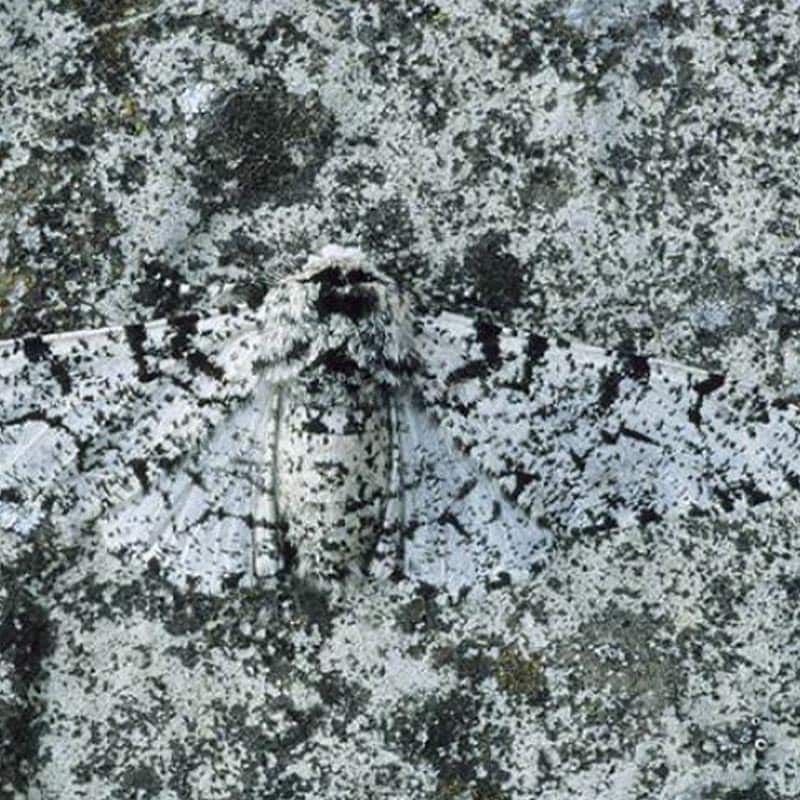
How did that moth above gain the superpower to effortlessly mix-and-match itself to its ambiance? Through natural selection. As other animals picked them off and snacked on them, they had no other choice but to slowly mimic their ecosystem.
Owl
Other animals, like that owl below, can change their plumage in order to adapt to their surrounding. Their bodies have an amazing ability where chemical changes can occur, altering their pigmentation over a period of time. Ain’t nature just grand!
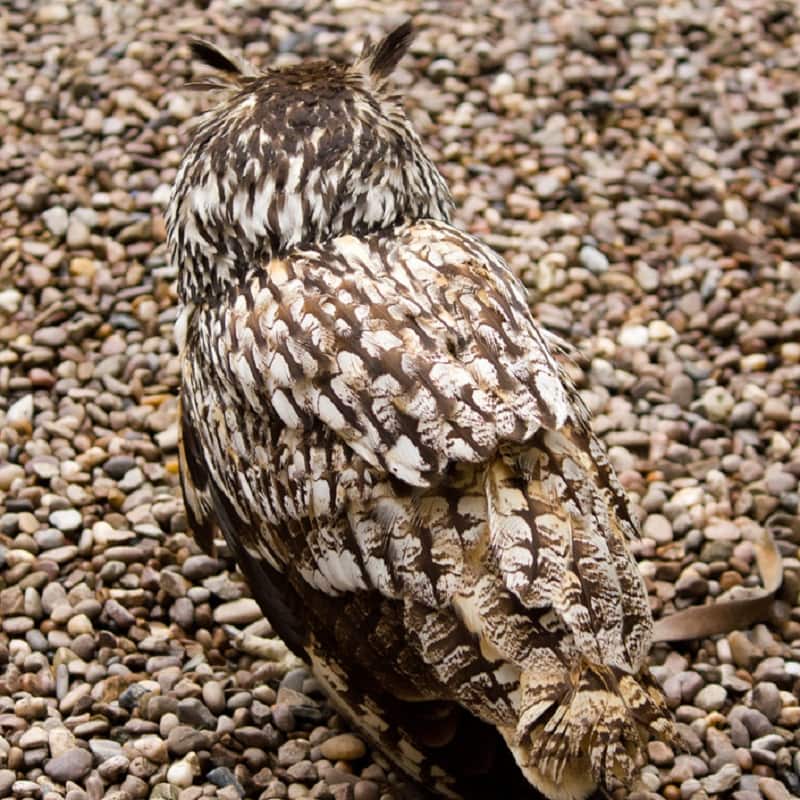
But why do certain animals, particularly apex avians like an owl, need to camouflage themselves? Well, because the ability also works for stalking and hunting prey. That owl above is probably tracking mice or rodents across the field.
Arctic Fox
The Arctic fox, as the name no doubt gives away, is a species of fox that lives in cold climates, mostly in the arctic region. Over time the animal has adapted its coat to mimic the snow. To totally blend into its surroundings.
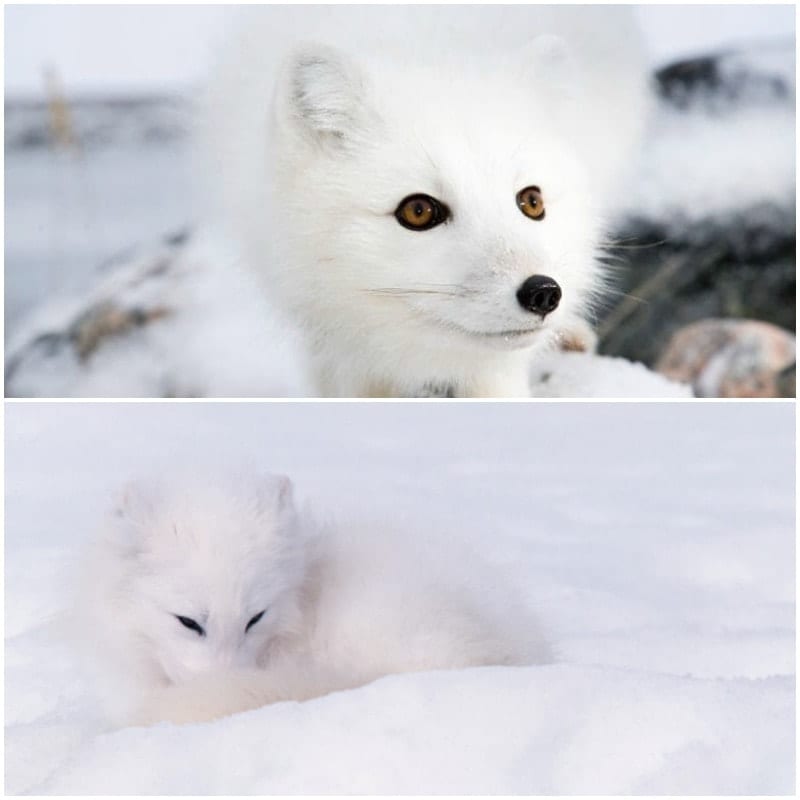
This occurs because the fox, unlike other animals, has the distinction of being in the middle of the food chain. They are both prey, as well as predator. A fox needs to hunt to survive while also hiding from other bigger animals that might like to snack on its hide.
Buff Tip Moth
You have to look carefully at the picture below, but there is a moth on it. Trust us; it’s there. The buff-tip is a moth found primarily through Asia and Europe with scattering concentrations in Siberia. Just in those parts.
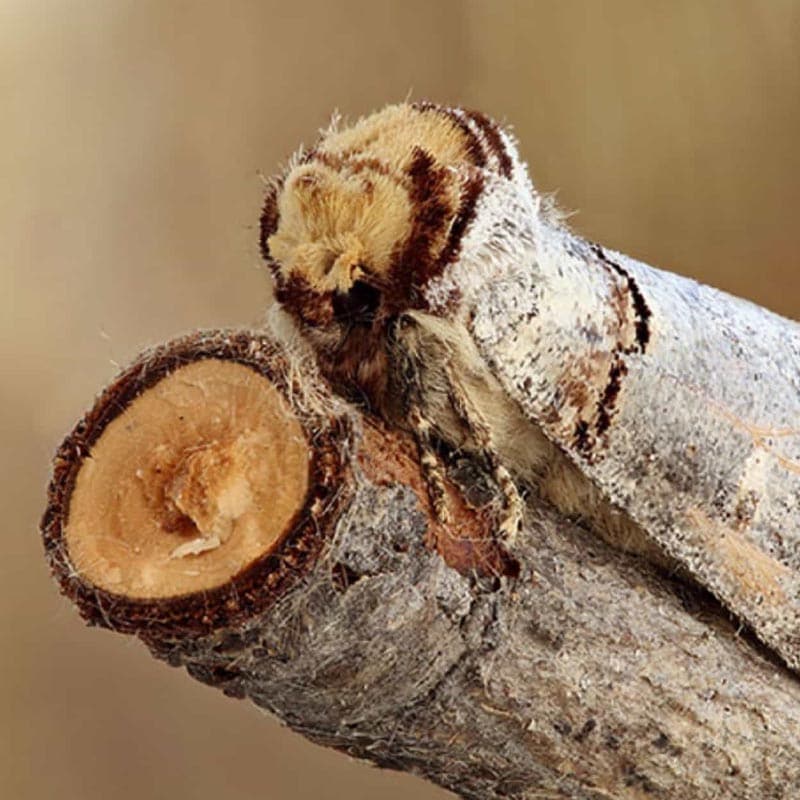
It is a solitary creature that mostly flies at night. You can spot them, due to their mating habits, in July and June. The animal has the tendency due to its thoracic hair to resemble a broken twig when in rest.
Bush Cricket
Tettigoniidae is an insect found in South Africa, Australia, Canada, and the United States) It is one of the most common types of crickets in the world, and due to its adaptive ability, it can mimic the ecosystem in which it resides.
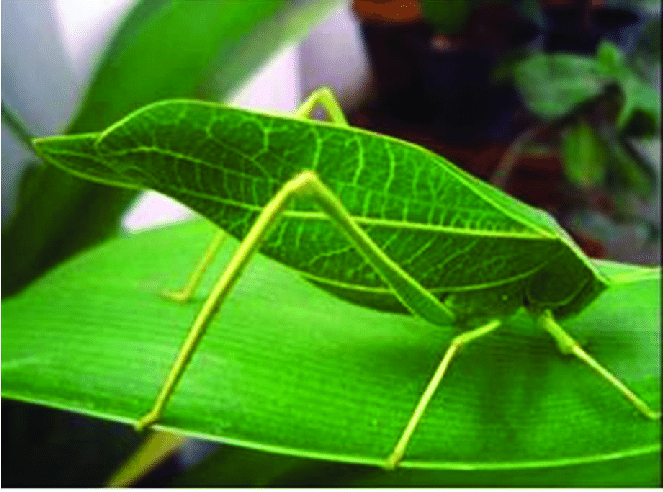
The bush cricket is unique because due to the fact that it always changes colors and mirrors its surroundings, it is one of the few species whose family group extends at an exponential rate. There are more than 6400 sub-types of this cricket.
Butter flower
The butter flower is a type of butterfly that not only has adapted to its surroundings but has actually become part of the spectacle of the ambiance. Buttercup flowers are found everywhere, and due to their amber and resin, they are always attracting butterflies.

The Butter Flower Butterfly grows in conjunction with the butter cups. Its lifespan is integrally linked to the flower’s durability it has decided to mimic and call home. When the flower dies, it also fails. It’s that ensnared in its lifecycle.
California Stick insect
The timema knulli is a stick insect native to California. Stick insects are an order of insects whose members were once known as ghost insects in Ancient Greece. Members of the species are found on every continent except Antarctica.
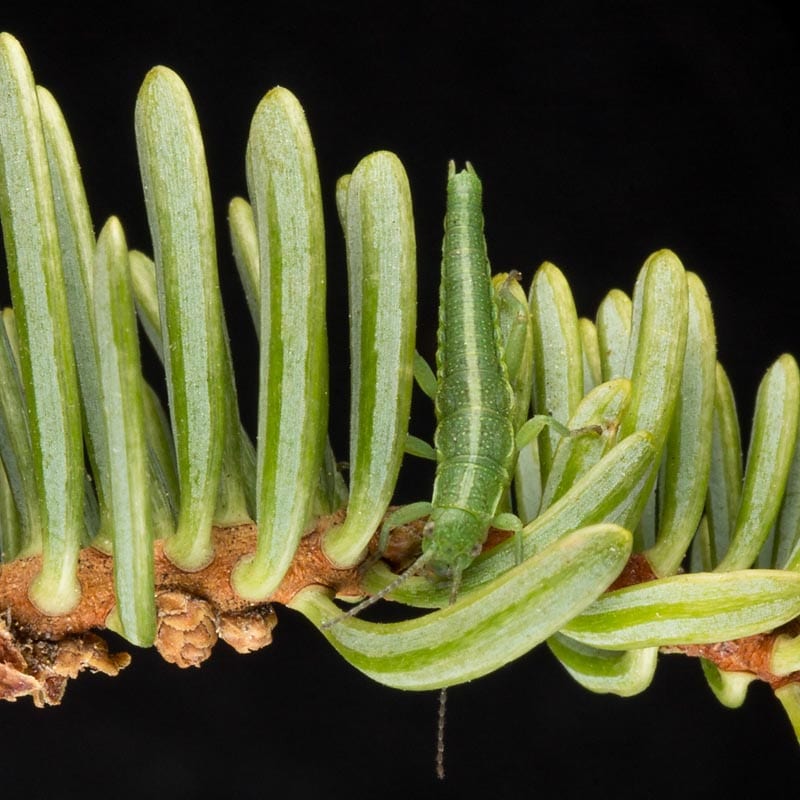
Some species have wings, and they can fly, becoming plague due to their ability to eat and reproduce at a staggering rate. In hotter climates, they breed year-round. Most are herbivores and live unobtrusively in trees and rarely interact with other animals.
Leopards
Felines are apex predators. That cute little cat you have roaming around your house has been perfectly crafted by nature to be a killing machine. The only reason it doesn’t rip your throat in two is that it has you on a leash doing its beg and call.
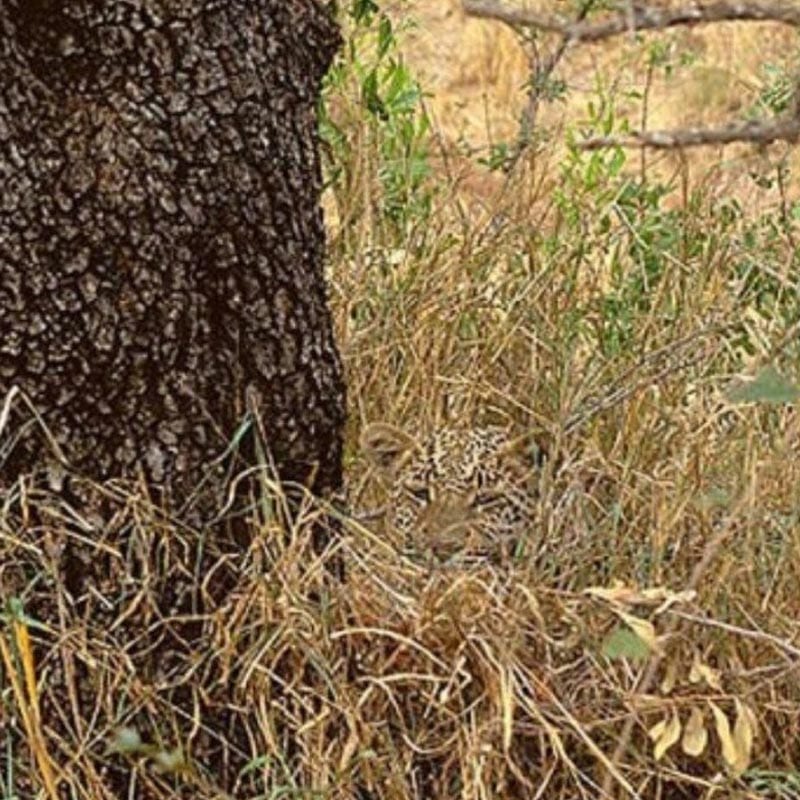
Leopards are just massive cats. They have all the traits of Mister Snuggle, only 20 times the weight and size. Genetically they are one and the same. Give or take a DNA strand. They can mimic their surrounding for hunting.
Children’s Stick Insect
Stick insects are the amazing ability to naturally tweak their bodies to the fauna they were born into. It took them decades and centuries, but they somehow managed to recreate their exoskeleton, so they look exactly like the flowers they inhabit.

If you have a yard, go outside, look around… there’s a chance that you’re probably being eyed by a couple of stick insects. You can’t see them, but they can see you. They can adapt so rapidly and ingeniously to a surrounding that most of the time, you don’t even know they are there.
Common Baron Caterpillar
Pull up that image from below, expand it, now, look at it very carefully… Do you notice it? That’s right; there’s something funky with the flower’s surface. Something irregular. Something that’s off. It’s a blink, and you’ll miss the whole thing.
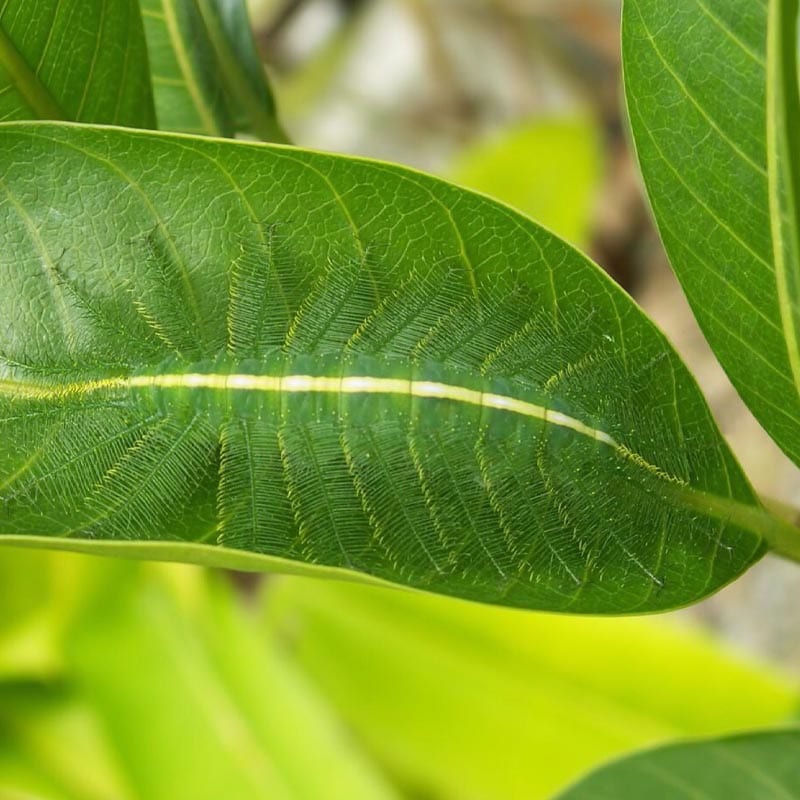
Common Baron Caterpillars can lay dormant for hours, even days, and the only way a person would be able to spot them is by the fact that they can’t hide their density. They add volume and mass to a leaf.
Copperhead
It’s there, right smack in the dead center of the picture. We had to look a couple of times until we spotted it. What makes this picture even more unsettling is that unlike all the other animals we’ve been through, that’s a copperhead snake.
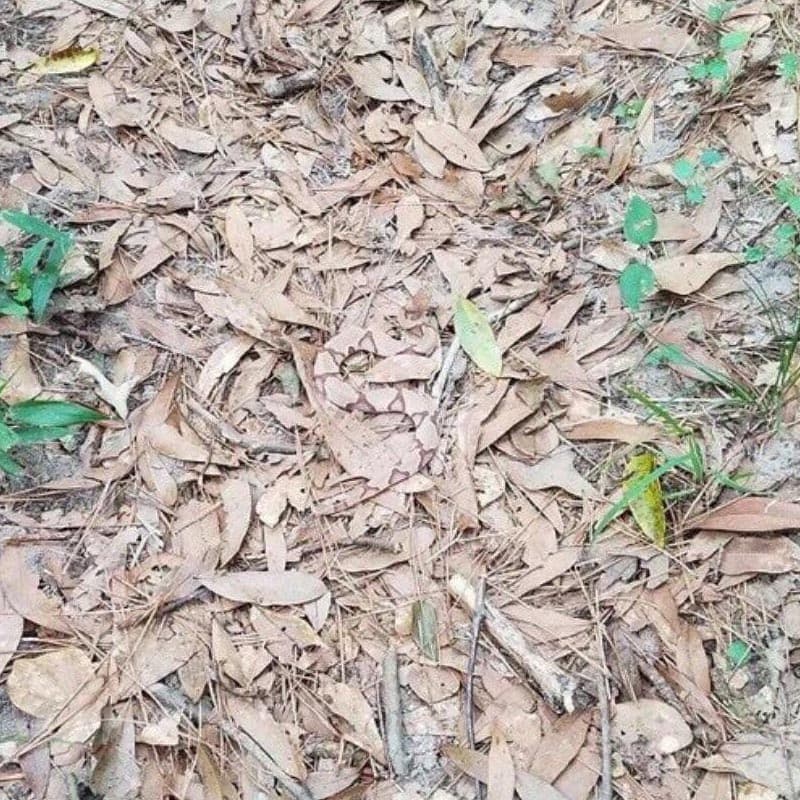
Copperheads are one of the most venomous pit vipers in Eastern North America. They are a common species with a huge range. They are constantly encountering hikers and other humans, and, in many cases, although they aren’t aggressive, they can attack.
Cuttlefish
The cuttlefish is a type of squid or octopus that belongs to the mollusk family of the order of sepia. They are referred to as “chameleons of the sea” and can change their colors in a matter of seconds.
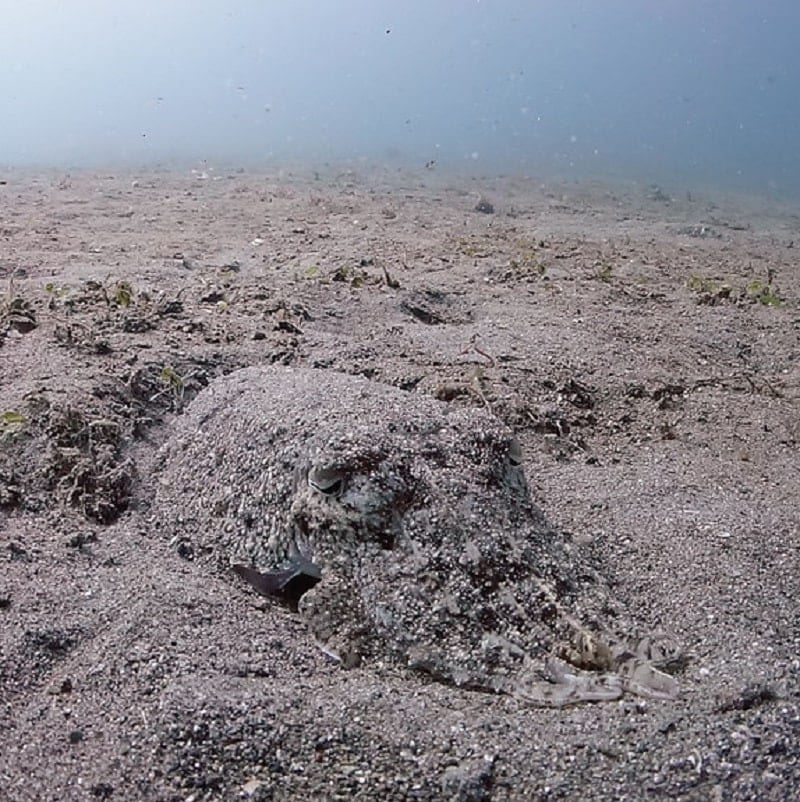
This color-changing ability is due to multiple types of cells that surround their body. One of the most distinctive things about this animal is that it uses that ability not only to blend but to communicate chromatically with other members of its clan.
Ghost Pipe Fish
Solenostomus also knows as ghost pipefish or false pipefish, is a species of fish closely resembling sea horses. They can reach up to 15-centimeter ins length and live in open waters except when breeding. Murky water they need to protect themselves.
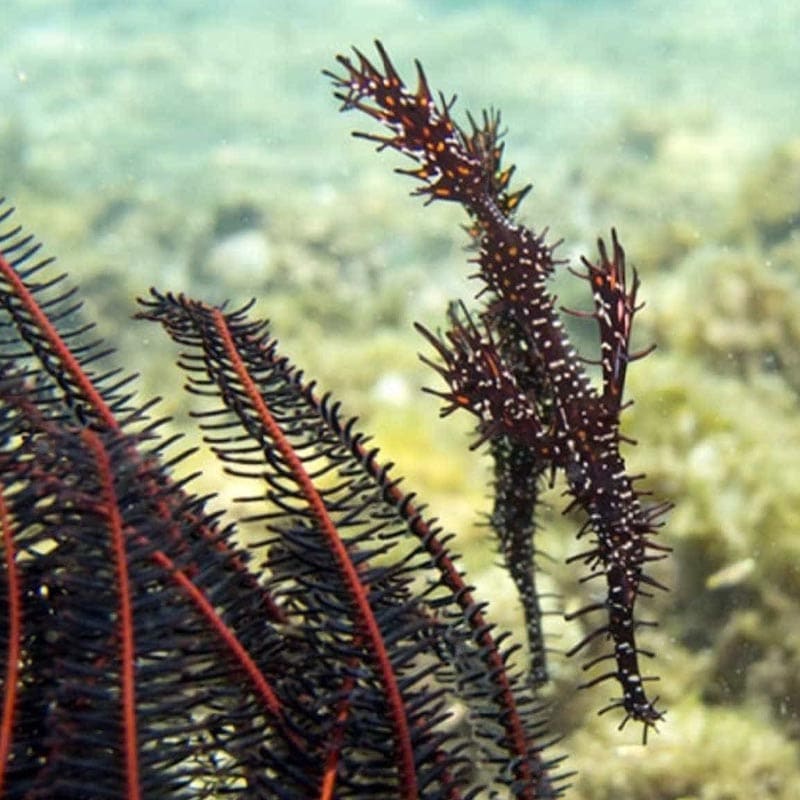
They are found in waters of the Indio-Pacific. The background noise, the algae, and the corral almost make them impossible to spot. Unlike other pipefishes, the star-shaped plates on its skin help it camouflage right into its surrounding.
Goldenrod Crab Spider
The Goldenrod Crab Spider is a species of crab spider mostly found in holarctic areas. They mostly come out for hunting in autumn. These spiders may be yellow or white and have what is called active camouflage, which allows them to blend into a flower.

The color of the crab depends solely on the flower they are hunting on. They are carnivores and mostly feed on invertebrate insects; bees, flies, other crabs, butterflies, grasshopper, and dragonflies. Their favorite meals are honeybees and moths of the region.
Gray Tree Frog
Frogs are one of the animals with the most active camouflage in nature. They tend to mimic their surroundings perfectly and rarely are spotted. Why is that? Well, frogs are delicious! Animals, primarily birds, love just to peck them from the ground.
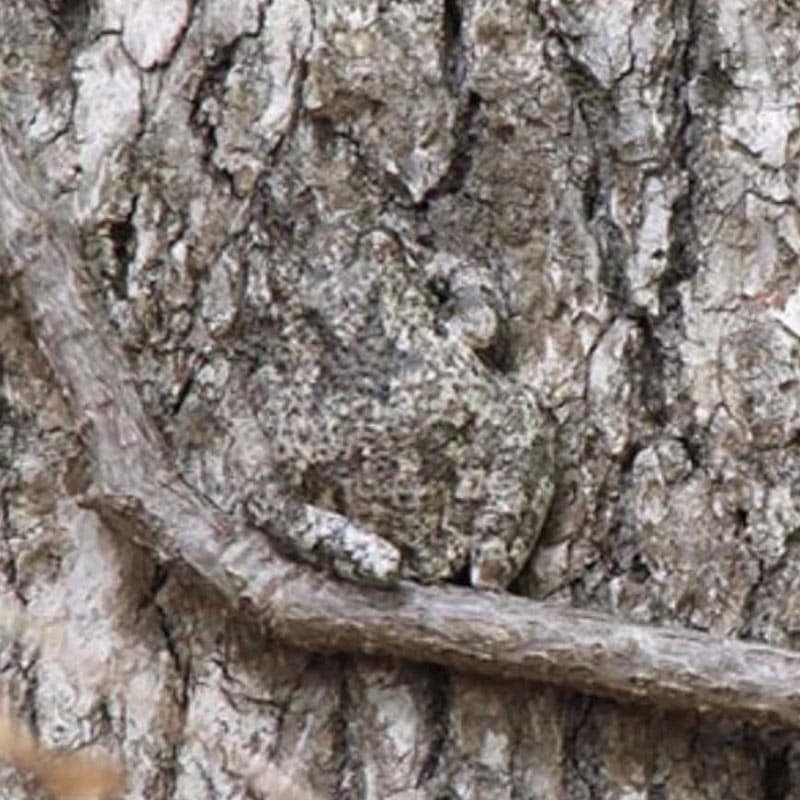
Frog’s ability to mimic their ecosystem isn’t just limited to their color and the way they adapt to the environment, but the fact they can reduce their heart rate and body temperature. They can also stop secreting hormones and smells… Fooling predators.
Great Gray Owl
Did you know that of all the avians in the world, the owls are the most vicious and cunning? They can mimic their surrounding, spot animals miles away, and are Lex Luthor level cunning. Everything is prey to an owl.
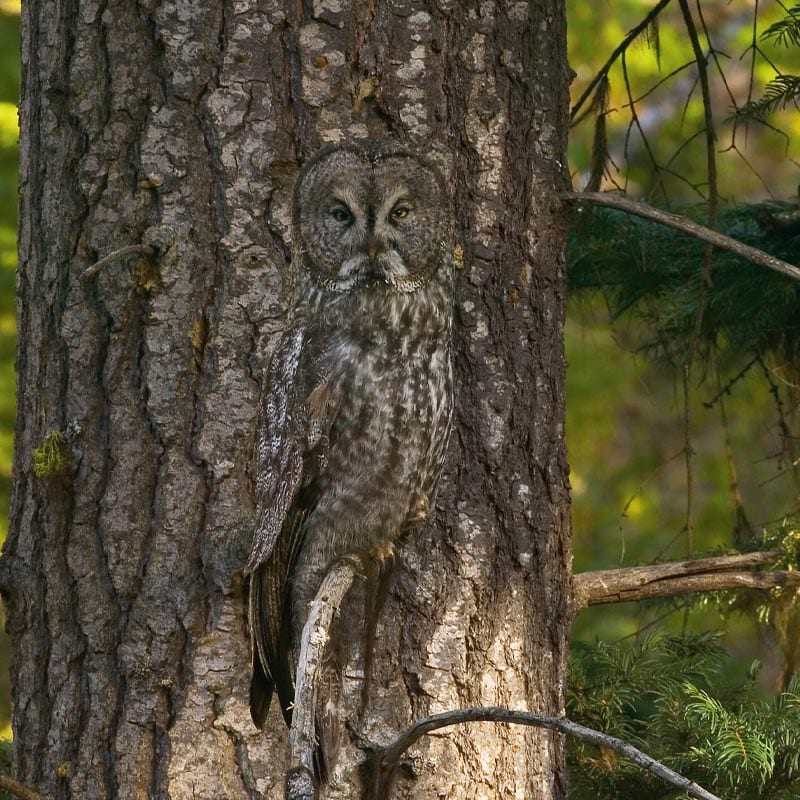
Owls have adapted so well to their environment that when they eat an animal, they can actually recycle the bones. Their stomach acid bleaches the skeleton, and then they regurgitate the desiccated body. Why? So they can construct their nest out of them.
Great Potoo
Potoos are a group of Caprimulgiformes birds. There are seven species and are mostly found in Tropical and Central America. They are nocturnal predators that mainly feed off incests and other smalls carapace animals, which the spot from up on high.
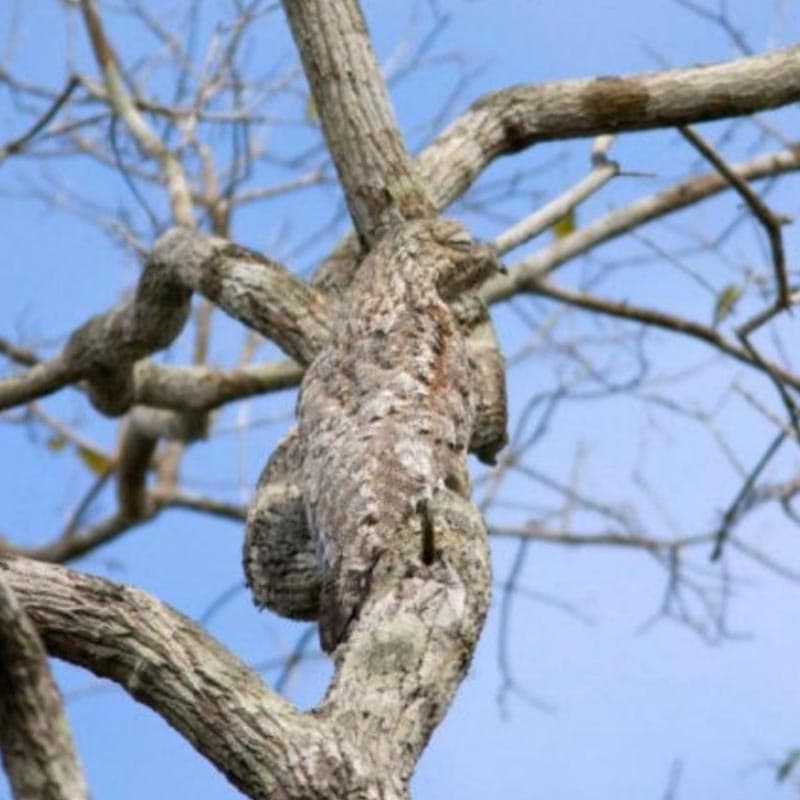
During the day, Potoos are usually found perched upright on tree stumps. Their active camouflage and pelt allow them to mirror the step. They can lay their eggs in that manner and not move an inch until they’ve hatched.
Ground Squirrel
Ground squirrels are more likely known by their country name of PRAIRE DOGS. They are medium-sized members of the squirrel family which normally live inside holes or borrows carved out of rock or the soil. They are omnivores.
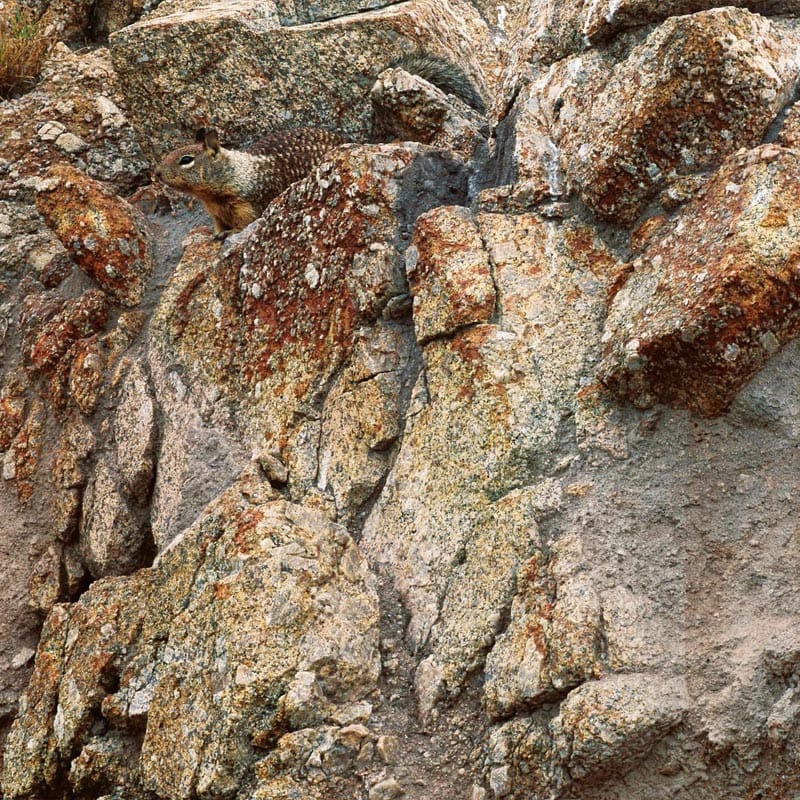
Ground squirrels are known to feed on just about anything they can lay their hands on and have the amazing ability to communicate with others of their clan. Forming pack mentality and attacking prey in herds. They can be found just about everywhere.
Hedgehog
O.K., let’s be honest, that’s not a very good camouflage. That little hedgehog isn’t exactly hiding. If you call that below concealment, then you need to have your eyes checked. Still, don’t you just want to pet and hug the little Sonic?

Hedgehog tries its level best to camouflage, but the reality is that they aren’t really good at it. That’s why, in order to protect themselves from other animals, nature has gifted them with those spines and bristles. For predators eating a hedgehog might not be worth the hassle.
Horned Adder
“Snakes, why did it have to be snakes?” A horned adder is an extremely venomous viper species found in southwest Africa. They are rare, but their bite is extremely dangerous. A bite by a horned adder can be highly toxic and even result in necrotic ulcers and shock.
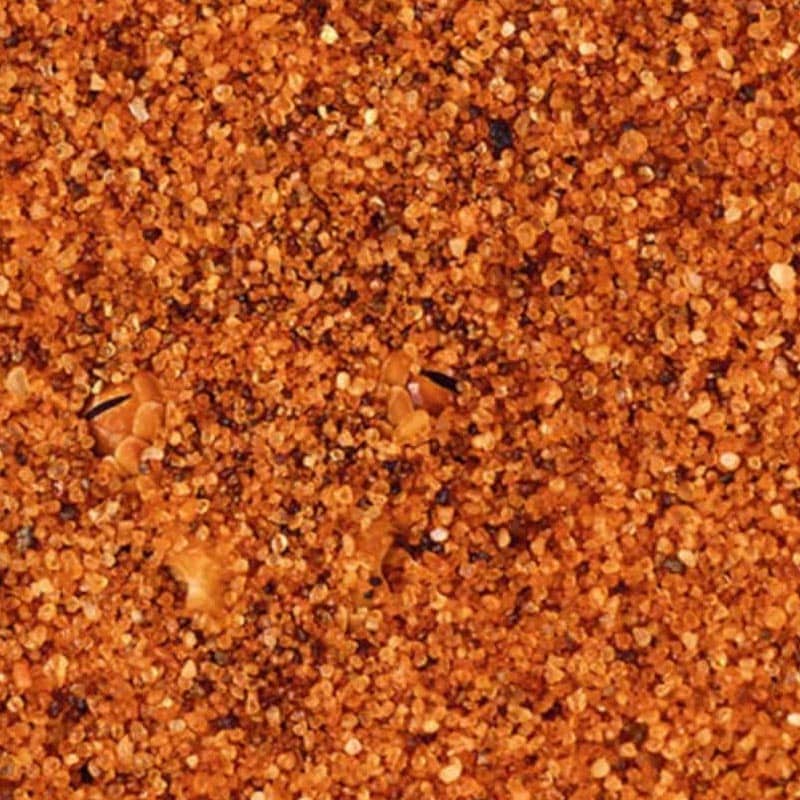
A number of deaths have occurred as a result of a horned adders bite. That’s why the fact that it can hide so perfectly in plain sight is so disturbing. These animals are perfect killing machines. They are fast, they are lethal, and they are cunning.
Horned Lizard
Also known as a horny toad or horn toad is a type of North American lizard that’s mostly found in the Texas region and surrounding states. In order to avoid predation, they can camouflage and change coloring rather quickly.

If approached, they run in short bursts to confuse predators. Another trick nature endowed them with is the fact that they are extremely difficult to swallow. They have large bodies and can actually puff their hides, so they appear more horned.
Impala
Impalas are medium-sized antelopes found mostly in eastern and southern Africa. They can weigh between 40-76kg and typically have lyre-shaped hornets. They are slick, fast, and slender creatures. And, they are also incredibly tasty to other animals in the area.
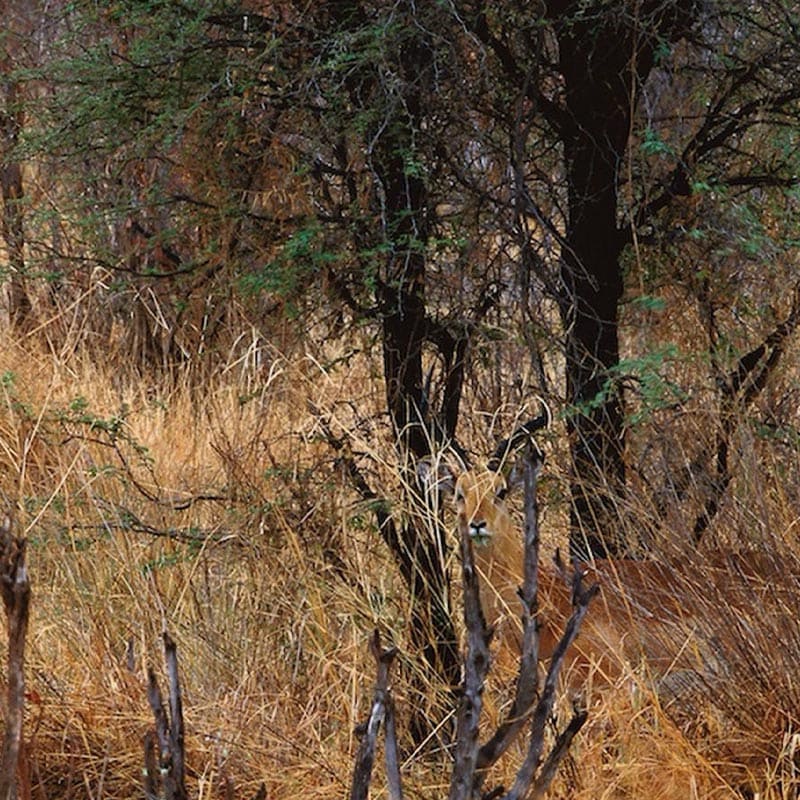
They are known, aside from their ability to hide in the brush, by their characteristic leaps. These jumps are anti-predatory strategies. It’s a way of asserting dominance over other animals. The Impala is a vulnerable species with its numbers declining due to hunting.
Leaf-Litter Mantid
The mantis is one of the largest families of insects found in the world. Most mantises are in tropical or subtropical areas. There are over 2400 species of mantises, and the one most people know about is the praying mantis.
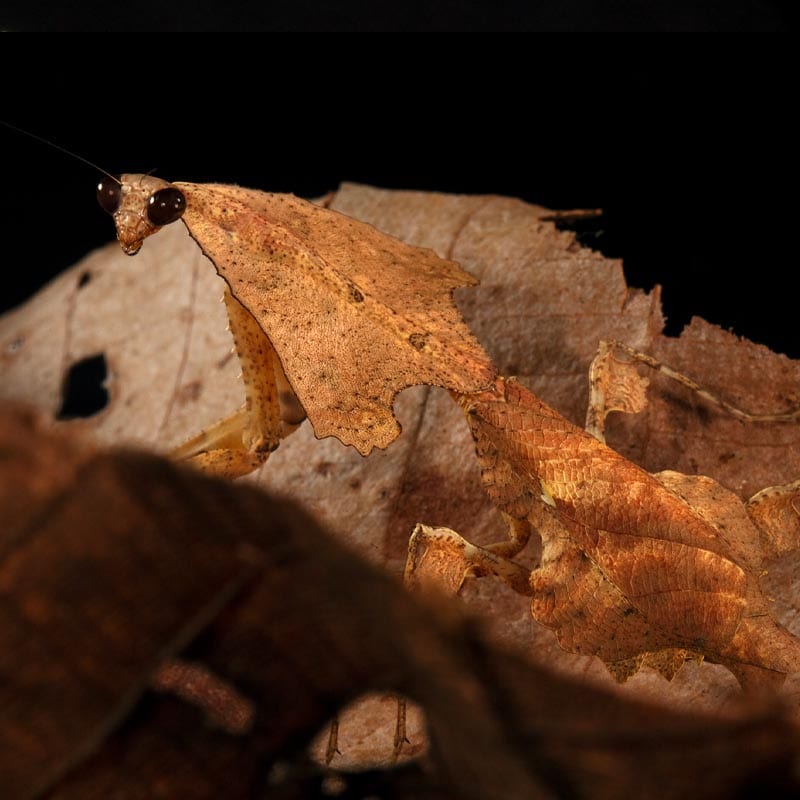
Mantises ate relatives to both termites and cockroaches. They are known for their sexual cannibalism, with the female mantis eating their mates after copulation. In ancient Greece and Egypt, mantises were thought to have supernatural powers and were kept as pets.
Leaf-litter toad
Not all frogs are toads, but all toads are frogs. Toads ate basically very ugly frogs. They are part of the Bufonidae family and are generally covered with large leathery skin, and moss. They are extremely apt at camouflaging.
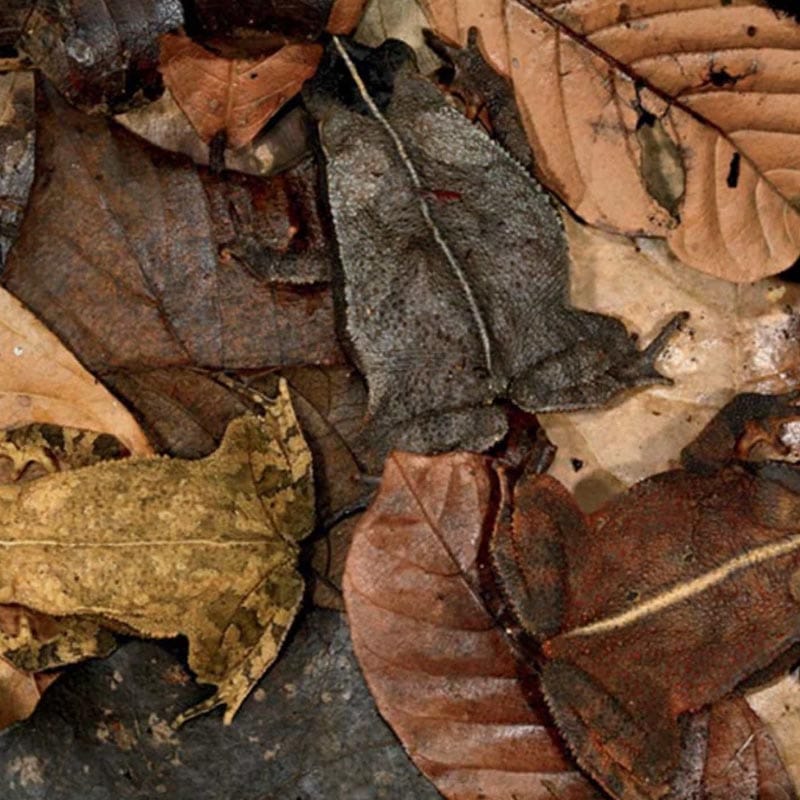
Toads are terrestrial animals and, unlike their counterparts, aren’t comfortable in the water. They have what is called “site fidelity.” They only breed amongst their tribe. That’s why it’s very hard for there to be sub-genius of the species, of account of the inbreeding.
Leaf-tailed gecko
Geckos are small lizards found in climates all around the world. They are unique because of their localization patterns, using chirps and clicking sounds to interact socially amongst their clan. They have an incredible ability to mimic their surrounding.

Geckos cannot blink. They lack eyelids and have a transparent fixed membrane that covers their cornea. That’s why these have excellent night vision. 350 times more sensitive than human color vision. They can adapt to all environments and are excellent hunters.
Long Fingered Scorpion Fish
Scorpionfish are a family of marine fish that includes the world’s most venomous species. The fish has a type of sting, as the name suggests, the has a toxic mucus. They are widespread in tropical and temperate seas and are mostly found in the India-Pacific region.
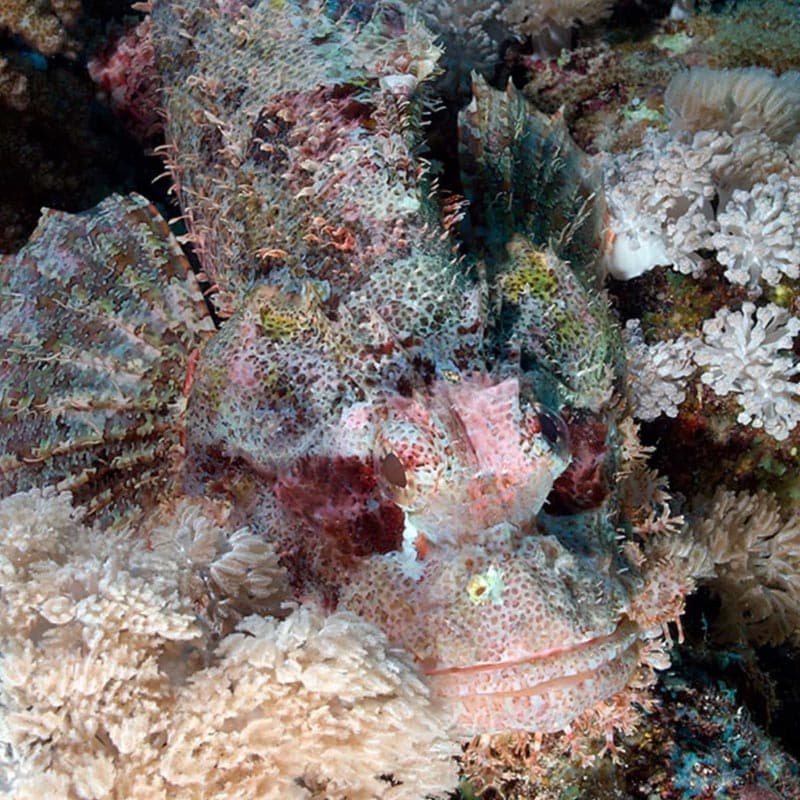
Scorpion fishes, such as stonefishes, wait in disguise for prey to pass them before launching an attack. They are suction feeders, and their venom can kill a person relatively fast. They are the terror of scuba divers; the good news is that they are not an aggressive species.
Long-Tail Potoo
As we’ve already discovered, Potoos are a type of avian that’s rather unique in its ability to mimic a tree stop when not in flight or out hunting. These animals are hard to distinguish and pick out from the surroundings and ecosystem.

But why do they hide and disguise themselves as tree stumps? Well, mostly because they use that position not only to hide from other predators, but also to give birth and protect their hatchlings. The Potoos can breed standing up.
Mapet Leaf Moth
The difference between a butterfly and a moth is incredibly subtle. There are few, if any, rules established. One very good principle is that butterflies have a thin antenna and small balls at the end of said antenna. Moths do not.
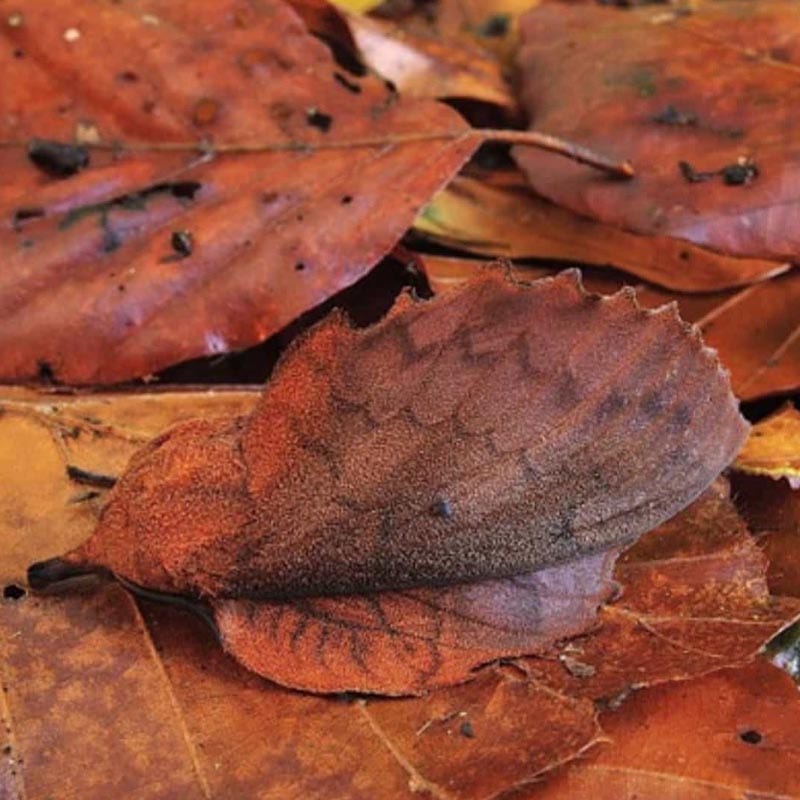
There are over 160,000 species of moths in the world, and most are either nocturnal or crepuscular. These insects can be found all over the world. The word moth comes from Old English, and it means maggot. The more you know.
Mediterranean Octopus
The octopus is a mollusk belonging to the cephalopod family. It is considered cosmopolitan mainly because it can be found in all parts of the globe. They can grow up to 1-3 meters in leaguing and usually hunt at dusk. Their diets consist of other mollusks.
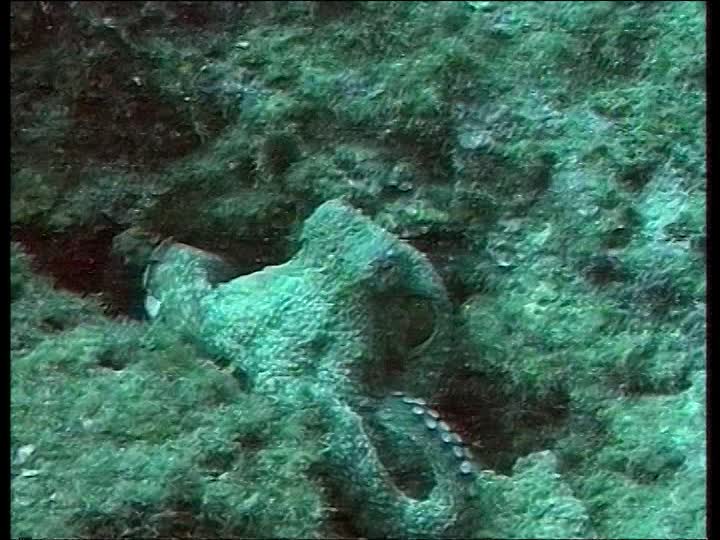
They also have an incredible ability to adapt and mimic their surroundings to the point that some can even change their colors. They can use these chromatic changes not only to hide but to communicate amongst themselves—one of the few animals that does that.
Mossy leaf-tail gecko
Geckos, as we’ve already established, are amazing creatures. They are one of the most versatile animals in the world. Aside from their uncanny ability to mimic their surroundings, geckos also have incredible eyesight and can run at impressive speeds.
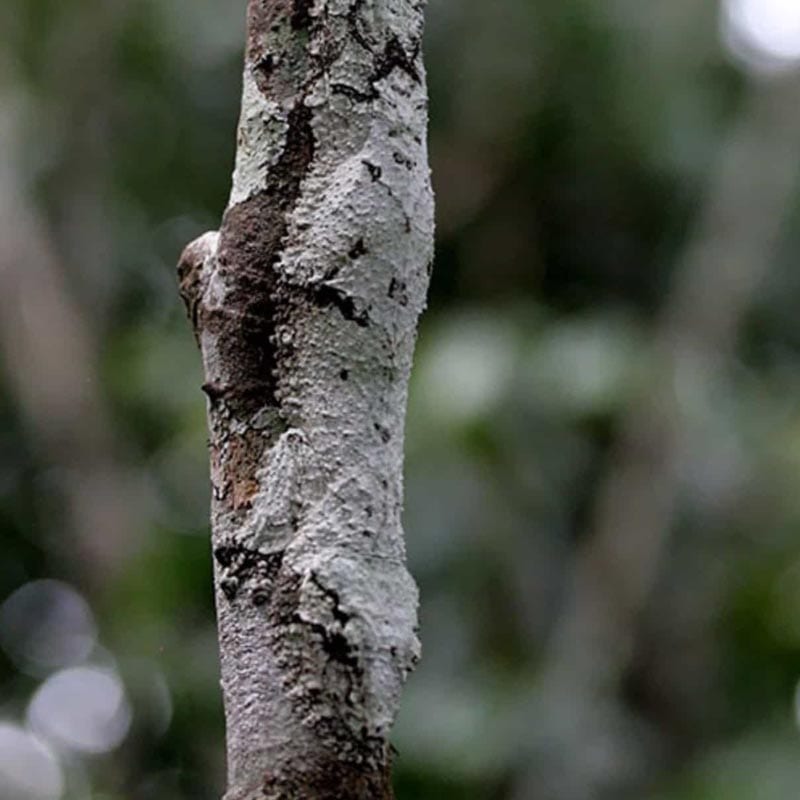
Some geckos can even mirror their cousin’s ability – the chameleon – to change color and adapt rapidly to a landscape. To the point, like the specimen pictured above that, it’s incredibly hard to distinguish it from its environs and ecosystem.
Owlets
Owlets are a small crepuscular avian related to nightjars. Most are found in New Guinea and Australia. They are insectivores that mostly hunt in the air; they pick small insects off the ground in daring bombing raids. In New Zealand, there was once a flightless species.
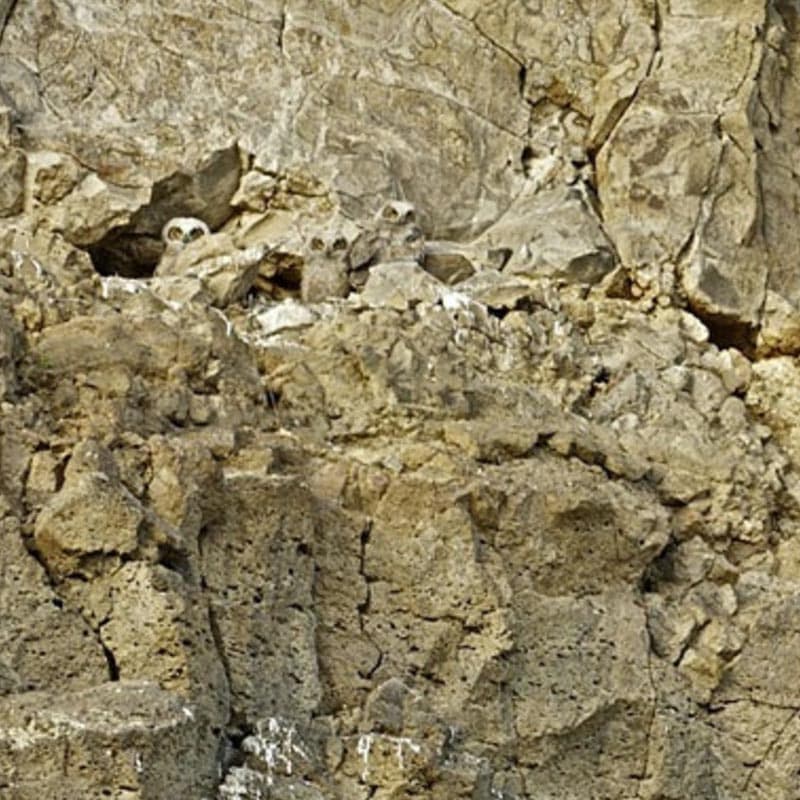
Due to their soft plumage and bizarre mixture of tan-like colors they can adapt to some of that area’s many outcrops and fields. Most owlets are predatory creatures that attack at a moment’s notice and use their camouflage to blend into their surroundings.
Rock Spider
Spiders are air-breathing arthropods. That’s right, similar to octopi. They are the largest and most common types of arachnids. They can be found almost in every continent except – you guessed it – Antarctica. They are everywhere and in every corner of the house.
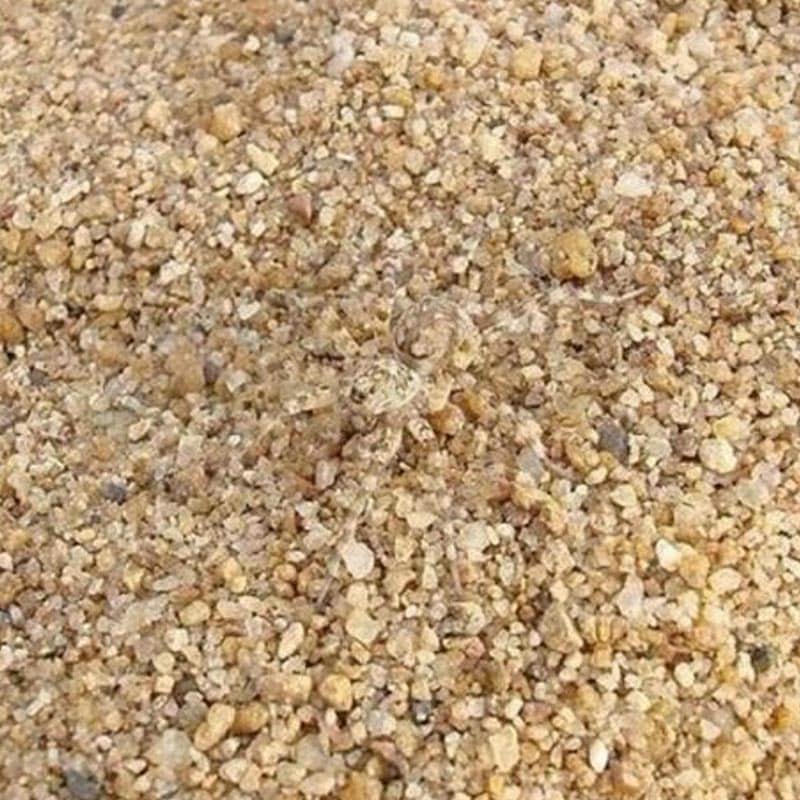
As of 2019, there are more than 48,200 types of spiders in the world. Spiders are highly trained killers, and they have the capacity, after eons of natural selection, to blend into their environment. Their exoskeleton has become “stained” in concordance to the place they call home.
Rockfish
The Madeira Rockfish is a species of scorpionfish, mostly found in the coastal waters of the Atlantic Ocean. It feeds primarily on crustaceans. It is a target species for fisherman and, although not in danger of extinction, its numbers have dwindled due to overfishing.

Rockfishes have venomous spines and can injure divers and swimmers. They tend to disguise themselves among the rocks of a coral, and unless precautions are taken, many individuals have a nasty encounter with them. They are not aggressive but will defend themselves if necessary.
Snow Leopard
The Snow Leopard is more commonly known as the ounce. It is one of the largest felines/cats found in Central and South Asia. It is a species listed as Vulnerable on many extinction Red List; It is estimated that less than 10,000 mature individuals exist in the world.
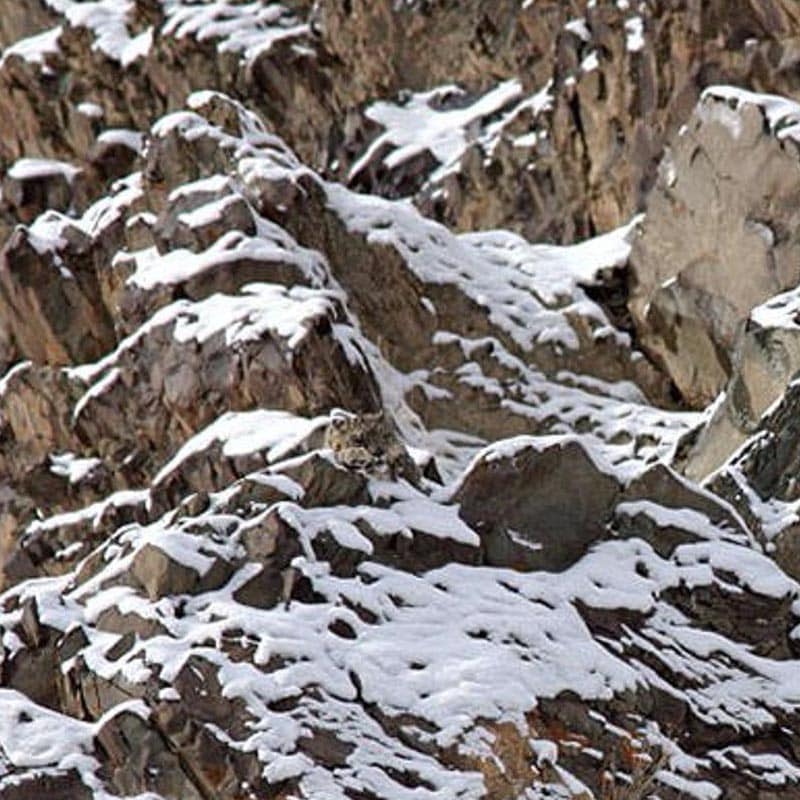
Snow Leopards have a white to gray hide, littered with spots, that make them incredibly versatile to hiding in their environment. They are superb hunters and one of the apex predators. The only thing they fear is other leopards and men.
Southern Pygmy Leatherjacket
Leatherjackets are a form of fish that is by far one of the most common in the world. The largest is about a foot long. Other leatherjackets you might be familiar with are pilot fish. They can be found in almost every ocean around the world.

The Southern Pygmy Leatherjacket is one of the smallest fish of its tribe. It’s a tiny creature with the distinct ability to disguise itself with its habitat’s plant life. They mostly feed on tiny mollusks and are hard to spot by divers.
Giraffe
The giraffe is one of the tallest terrestrials animals in existence. They have been intriguing to many many many cultures; some even worshiping the animals as gods or messengers with celestial power. They are mostly found on the African continent.
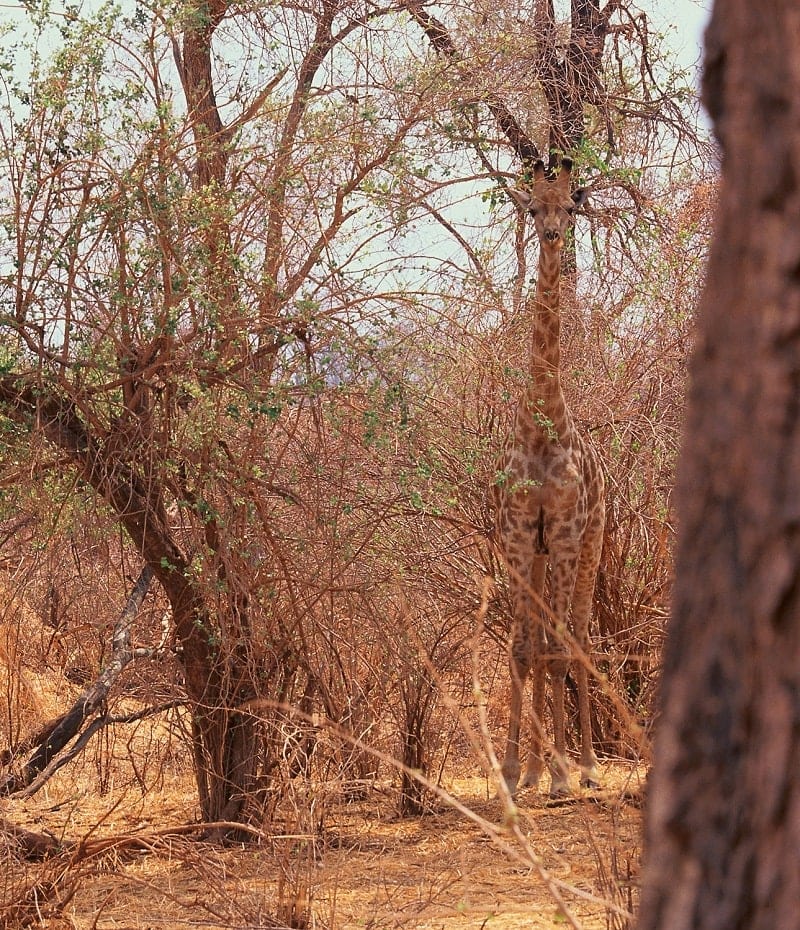
There are dozens of sub-species of giraffes on the planet. There were more but overtimes they’ve become extinct due to hunting and poaching. Most giraffes can mimic their surroundings due to their skin and colors. They are herbivores, and other animals love to eat them up.
Stick Insect
Phasmatodea is the official name of the stick insect family. In ancient Greece, they were thought to be mystical animals due to their resemblance to trees. So much so that the word PHASMA means phantom or apparition… so it means ghost insect.
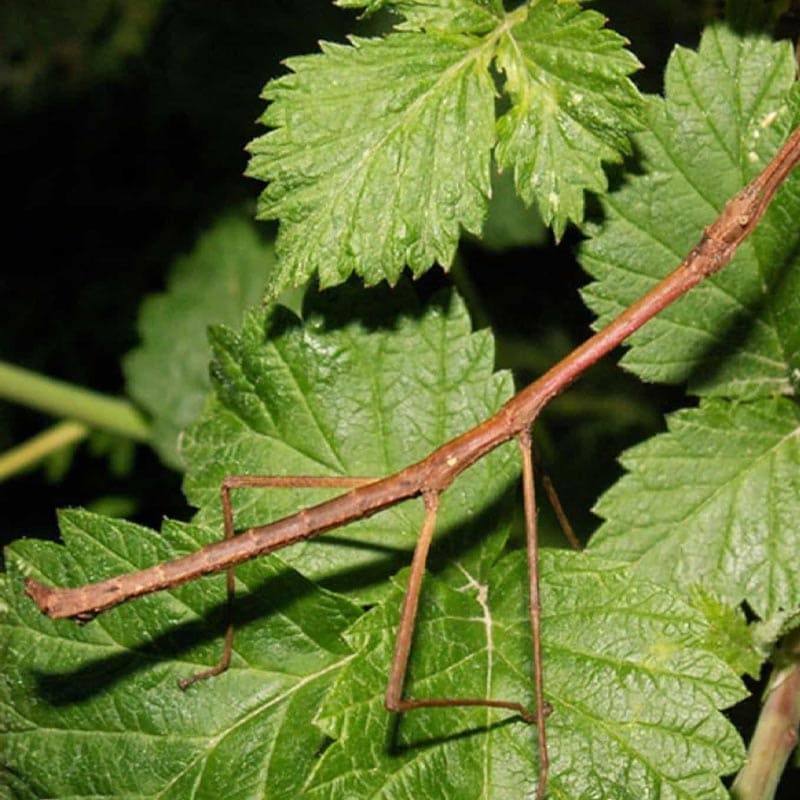
They have a natural camouflage ability and a captive female of the species can prodice hundreds of all female offspring without mating . They die once they’ve laid their eggs and slowly witter and root with the tree they used in autumn. They are slightly toxic.
Adelphia Serpa Selerio Caterpillar
Caterpillars are really just moths and butterfish in the making. They are the larval stage of these animals. Most are herbivores; only 1% are cannibalistic. Various forms of caterpillars are used not only as food but for silk and even as biological pest control.

Caterpillars have soft bodies. They can vary in size and have a fantastic ability to camouflage and disguise themselves. Why? Because they are rich in protein and are continually being attacked by other animals. One of the ways they fight this predation is with their natural camouflage.
Peacock Flounder
The peacock floured has the ability to change its colors and patterns depending on its environment. The fish, also called the flowery flounder, is found in hollow waters off the Pacific coast. Its eyes are on the top and not the side like other fishes.
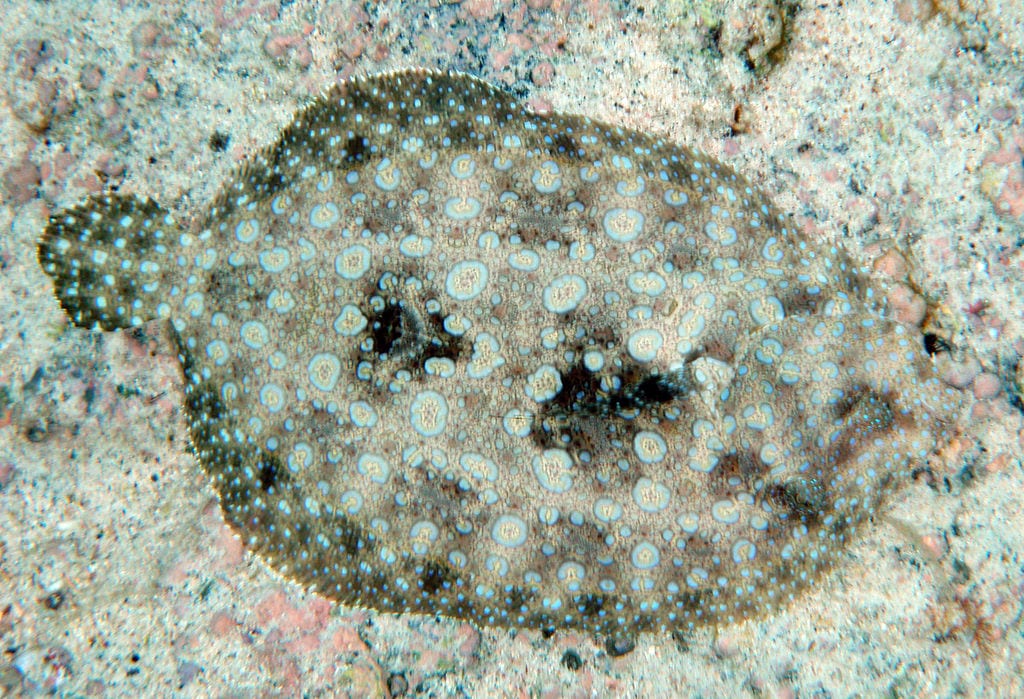
They are masters of camouflage with helps them to avoid detection from predators. The founder matches the ocean surface’s colors by releasing pigments to the surface of its skin cells. They use their eyes to match said colors.
Gaboon Viper
Gaboon Vipers can be found in sub-Saharan Africa. It is a venomous viper with the longest fangs of any snake of its kind. Primarily nocturnal. They are slow animals that usually hunt by ambushing their prey and anesthetizing it with its venom.
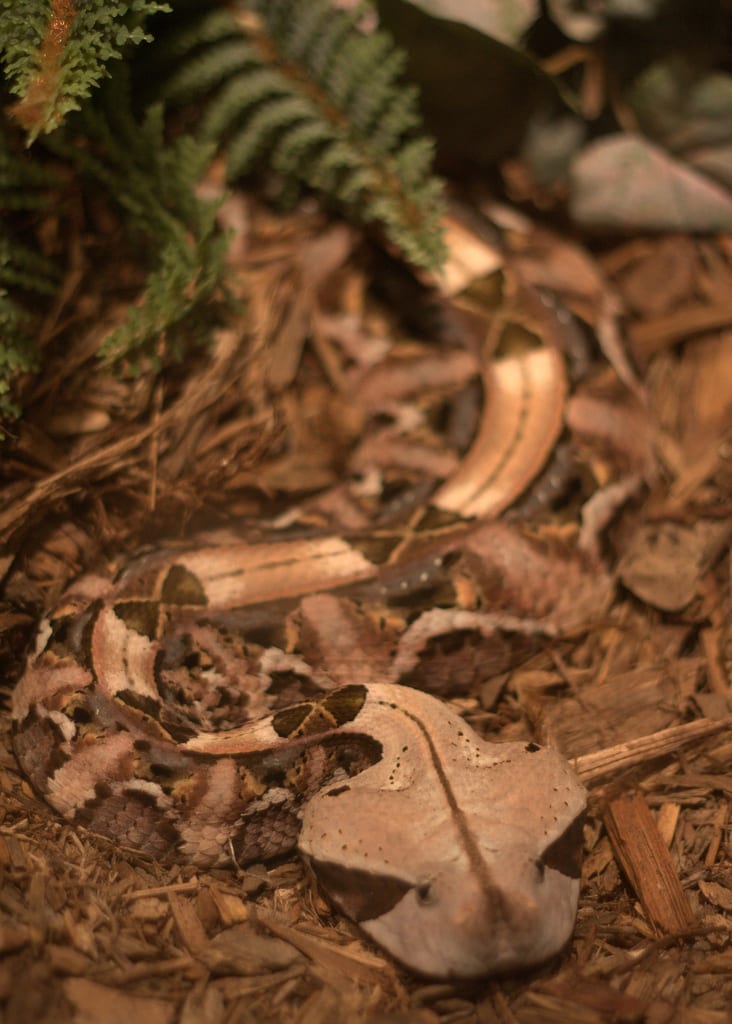
Bites from Gaboon Vipers, due to their habitat and remote nature, are extremely rare. Antivenom should be administered immediately if a person is attacked due to the venom being highly toxic; a bite can lead to death in a matter of minutes and should and considered a medical emergency
Jumping spider
The jumping spider is one of over 6000 spider species on the planet. Jumping spiders have one of the best vision among many arachnids. It is by far one of the most capable hunters of its kind. Agile, fast, and cunning.
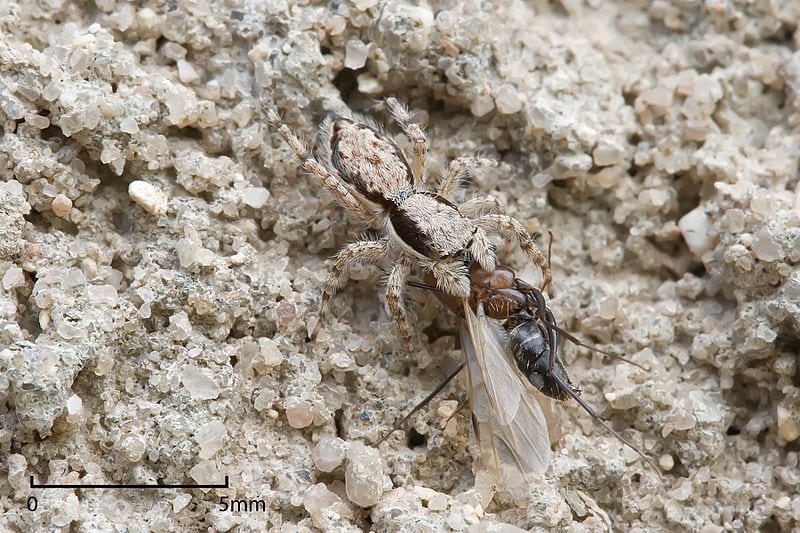
The Jumping Spider has the ability to jump notable gaps while hunting. It can also camouflage into its ecosystem due to its distinctive pattern. They have what is called disruptive colorations, which helps with contrasting patterns and shadow play.
Decorator crab
Certain species – the decorator crab – can cover themselves in sponges and algae to serve as camouflage. This is called sea-decoration camouflage when an animal doesn’t have a natural capability for camouflaging but uses the environment’s many tools to blend in.

Crabs of all species tend to do this. Whether is by employing algae, seaweeds, or fine particles of sand. They normally do this not only to conceal themselves against predators but to ambush prey. It is both hunting as well as a survival tactic.
Flower Mantis
The flower mantis is able to lure insect prey by mimicking orchid blossoms. They are a species of praying mantis and are a great example of what is called aggressive mimicry. Aggressive mimicry is a camouflage tactic that predators use in order to capture and entice prey.
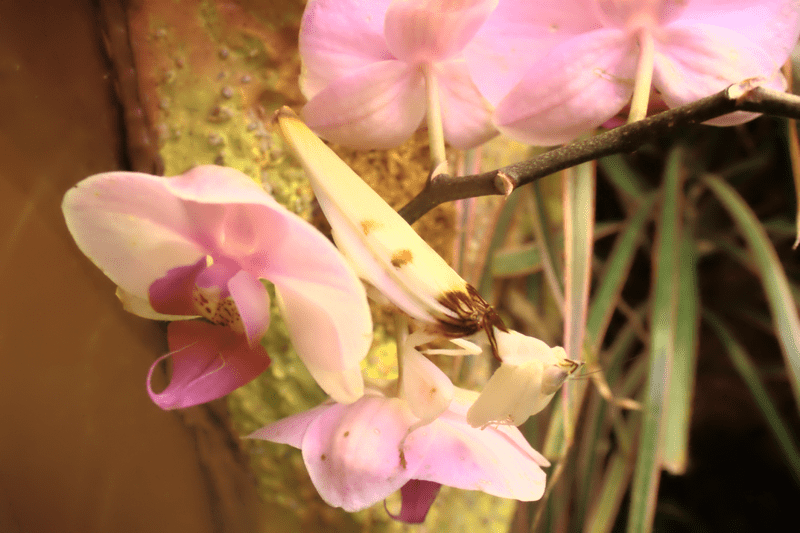
Flower mantises are semi-opalescent and have empty liquid globules that they can fill with different colors extracted from plants. They basically become the plant and what for an insect to get near. Once a prey comes into their line of sight… SNATCH.
Gum-leaf Grasshopper
The gum-leaf grasshopper is one of the many groups of grasshoppers that can be dated to the early Triassic period. They are age-old insects that have been around for more than 250 million years. They are by far older than man.
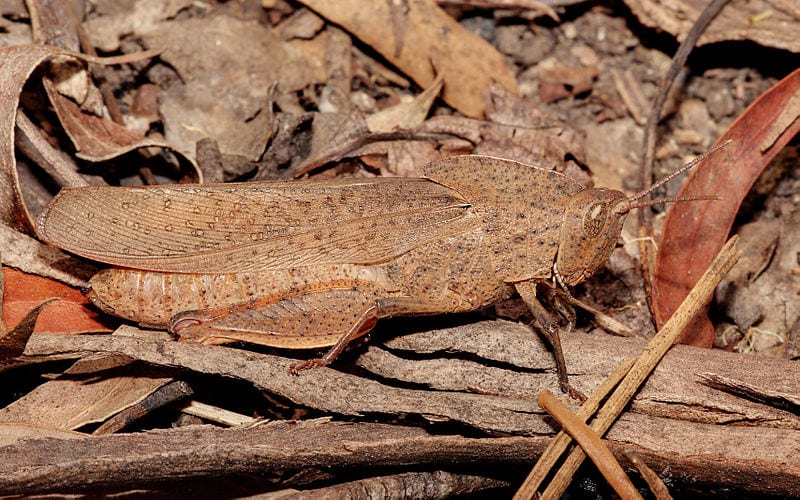
Grasshoppers are normally ground-dwelling insects with strong hind legs. They employ these handles not only to make their distinctive mating call but also to escape from threats. Among its many survival tactics, which they have developed over time, is the fact that they can mimic their surroundings.
Cuckoo
Cuckoo birds are the ultimate mimics. Right from birth, they take advantage of their ability to disguise themselves… hell, even before they even hatch. Below are two kinds of eggs. Notice any difference? Do they look the same?

Cuckoo eggs can mimic other eggs around their surroundings. Why? Because cuckoos use this natural ability to plant their eggs in another nest. Why? Again you ask. Free babysitting! Another bird will take care of the eggs as if they were their own. Marvelous!
